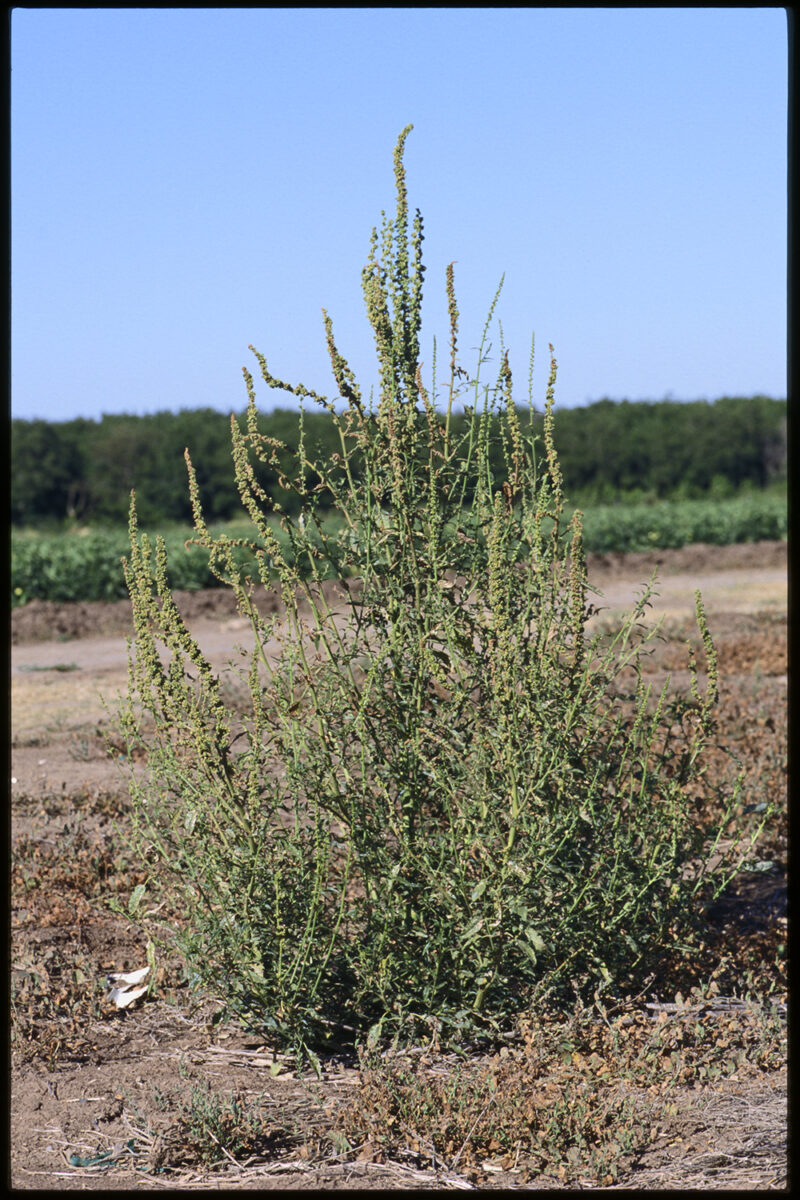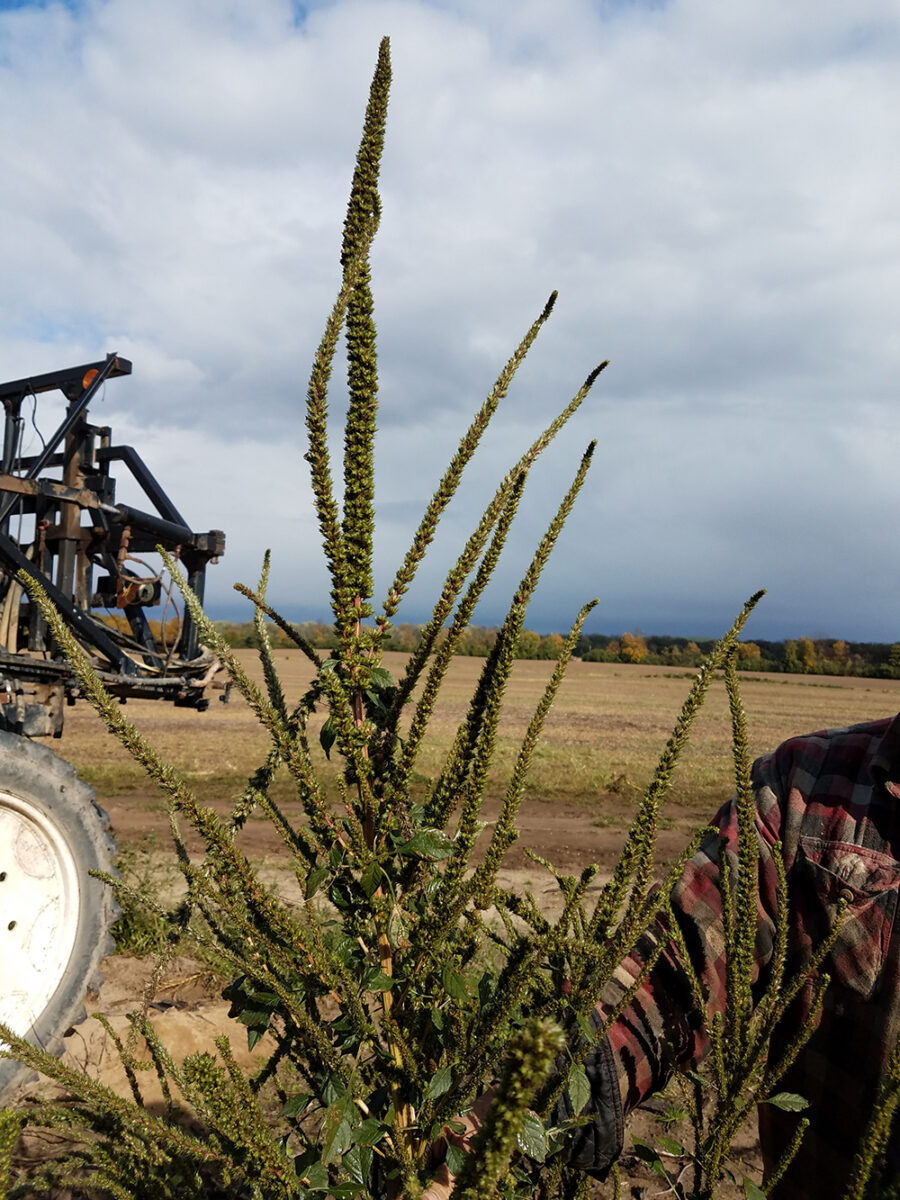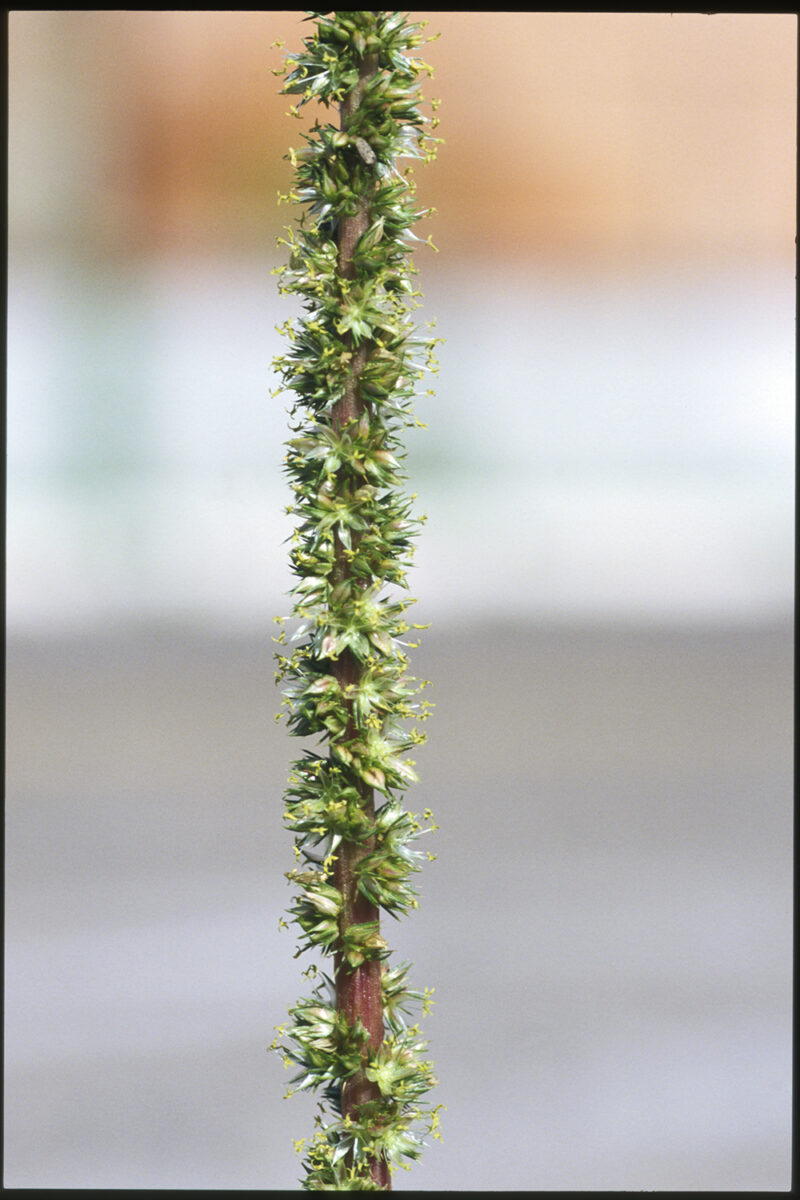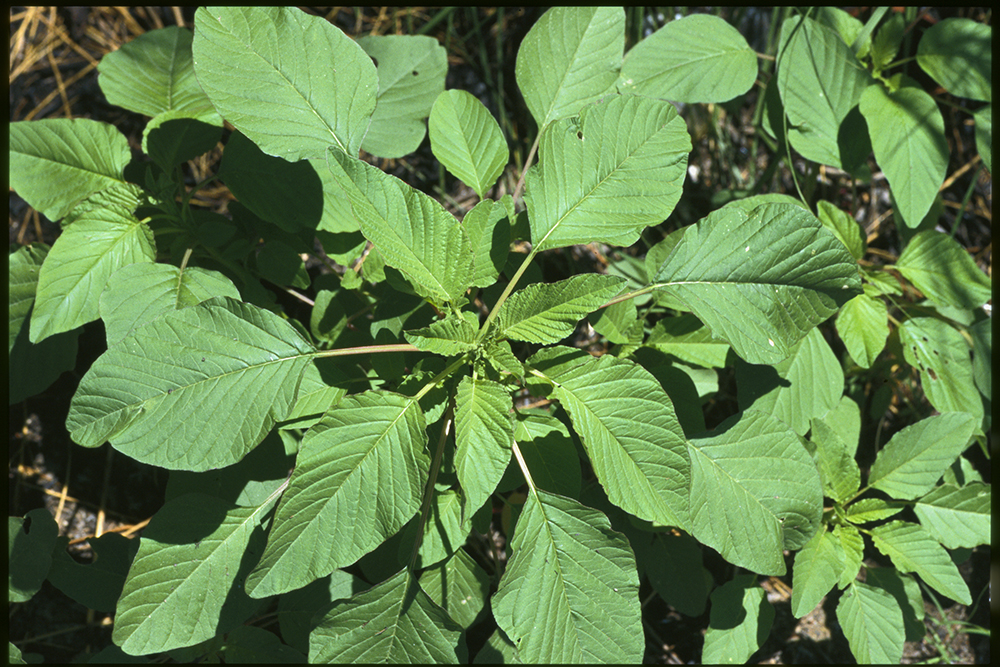Other common names: carelessweed, Palmer pigweed




Amaranthus palmeri S. Watson
Identification of Palmer Amaranth
Family: Pigweed family, Amaranthaceae
Habit: Tall, erect annual herb
Description: Seedling stems are usually red, sometimes green and sometimes slightly hairy. Cotyledons are lanceolate, hairy and red to green in color. Young leaves are alternate, egg shaped and roughly five times longer (0.4–0.5 inch) than wide, with notched tips. The coarse, red stem of mature plants will reach 1.5–6.5 feet tall with long, thin branches spaced far apart on the stem. Upper stems and branches are greener, less hairy and have narrower, pointier leaves than those located lower on the plant. Leaves are alternate, hairless, egg shaped to lanceolate, 2–8 inches long by 0.5–2.5 inches wide, with conspicuous white veins on the undersides and long leaf stalks. The relatively shallow taproot is reddish near the soil surface. Plants are either male or female, with individual, inconspicuous, green flowers grouped in spikes; spikes are soft or lightly spiny, thin, 0.3–0.8 inch wide, often nodding and largely unbranched. The longest spike is located on the main stem; smaller spikes are present at branch tips and in upper leaf-stem joints. Terminal spikes of male plants are yellow and 0.5–1.5 feet, with thin, triangular, green bracts around individual flowers. Female spikes are similar, with thick, stiff, notched bracts with a small spine located in the notch. Fruits are brown, triangular or pyramid shaped sacs, with three to five spines at their tip; sacs rupture at maturity, releasing one glossy, round, dark red-brown to black, 0.04–0.06 inch-long seed.
Similar species: Palmer amaranth seedlings are similar to seedlings of redroot pigweed (Amaranthus retroflexus L.), smooth pigweed (Amaranthus hybridus L.), Powell amaranth (Amaranthus powellii S. Watson) and waterhemp [Amaranthus tuberculatus (Moq.) Sauer]. Mature Palmer amaranth has thinner stems than redroot pigweed, and its combination of non-wavy, egg-shaped, round-tipped leaves with very long leaf stalks and white veined undersides sets the mature plant apart. Other Amaranthus spp. have crowded, highly branching spikes, different from the long, nodding, thin, lightly branching terminal spikes of Palmer amaranth. Only waterhemp is like Palmer amaranth in having separate male and female plants.
Management of Palmer Amaranth
Since Palmer amaranth has a relatively short-lived seed bank, rotation of land into several years of a perennial sod should reduce population levels substantially. It will rarely be a problem in winter grain crops and early planted spring grains since these crops do most of their growth before this weed emerges in late spring. Since they are harvested before it matures, tillage after grain harvest interrupts the weed’s life cycle.
Since Palmer amaranth seeds must be near the soil surface for successful emergence, inversion tillage reduces densities of the weed relative to reduced tillage systems. Nevertheless, because the species often produces such a prodigious number of seeds, even in competitive crops, annual tillage will still not eliminate all seeds that can emerge to infest the crop. High seed retention on plants at harvest suggests the potential utility of seed collection and destruction during combining. Removal of harvested residue and chaff from the field reduced subsequent Palmer amaranth populations by up to 70%.
Palmer amaranth is among the fastest growing of all weeds. Its photosynthetic rate is very high, even for a C4 species, and its leaves track the sun, which ensures a high photosynthetic rate throughout the day. When plants are small, they can double in size every two to three days, and plants can reach 4 inches tall two weeks after the seeds begin germination and over 6.6 feet by maturity. Root growth is also five-fold greater than that of soybeans. This gives the weed an advantage in competition for water and nutrients. The extremely rapid emergence and growth of Palmer amaranth means that seedlings are only briefly susceptible to rotary hoeing and tine weeding, and good timing of operations is particularly important when managing this weed. In corn and sorghum, two pre-emergence blind cultivations may be useful, one about three days after planting and the second just before crop emergence. Similarly, tine weeding or rotary hoeing at close intervals (e.g., four days) after crop emergence will also reduce populations. This will require slowing tine weeders down when the crop is very small, but early control is critical: The rapid growth means that any early emerging seedlings that escape will be too big to bury by the time row crops are large enough to hill.
High corn density and irrigation improved corn competitiveness against Palmer amaranth in Kansas. Increasing the population of drilled soybeans suppressed Palmer amaranth emergence in Arkansas. Since soybeans will germinate and grow at soil temperatures too low for germination and growth of Palmer amaranth, early planting can give the soybeans a competitive head start against this weed. Alternatively, a period of fallow with repeated shallow tillage in late spring can flush a large proportion of the seeds out of the surface seed bank, resulting in less weed pressure in the crop. The long season of emergence, rapid growth and exceptional seed production potential of Palmer amaranth makes all of the tactics discussed above only partially effective. In addition, development of glyphosate resistant populations appears to have facilitated the rapid development of taller, more aggressive plants that are better adapted to compete in various crop canopy structures. Good control may require hand pulling plants before they go to seed.
Black plastic mulch is effective for suppressing most Palmer amaranth in vegetable crops, but plants that emerge through planting holes can overwhelm crops. In bell pepper production, Palmer amaranth plants should be removed from planting holes within five weeks of transplanting the crop. Cover crop mulches can contribute to integrated management of this small seeded species. Residue from a rye cover crop suppressed a Palmer amaranth population by 57–58% in Arkansas. Even a relatively light layer of rye mulch (980–1,960 pounds per acre) can reduce Palmer amaranth density by over 70%, but rye mulch biomass generally needs to exceed 8,900 pounds per acre for greater than 80% Palmer amaranth suppression. This level of rye requires early fall planting and high residual soil nitrogen. Two years of a rye cover crop following a single inversion tillage to bury surface seeds controlled Palmer amaranth by 92% compared to 69% by inversion tillage alone. Incorporation of winter brassica cover crops, including turnips, garden cress, oilseed rape and Indian mustard suppressed Palmer amaranth in transplanted bell peppers by over 40%.
Ecology of Palmer Amaranth
Origin and distribution: Palmer amaranth is native to the canyons and desert washes of the Southwest. In the past 50 years it has become a problem weed in much of the Southeast and the southern Midwest. It now occurs sporadically northward to Wisconsin, Ontario and Massachusetts and can successfully compete with crops and complete its life cycle throughout Illinois. It has also been introduced to Europe, Asia and Australia.
Seed weight: Mean population seed weights vary from 0.44–0.49 mg.
Dormancy and germination: Some newly matured seeds can germinate immediately, but most are dormant. Seeds produced from spring emerging plants have higher germinability (40–70%) than those produced by fall emerging plants (15–20%). Palmer amaranth has a minimum temperature threshold for germination of 63°F, and in field conditions seedlings begin emerging when temperatures near the soil surface reach 64°F. It germinates best at 86–99°F and can germinate in day/night temperature regimens as hot as 113/104°F. Fluctuating temperatures provide moderate promotion of germination. After seeds have been buried or left on the soil surface for six months, light increases percentage germination. Reduced light levels and reduced day/night temperature amplitude under a closed soybean canopy reduced Palmer amaranth emergence up to 76%. At optimal temperatures, germination is very rapid, with most seeds germinating in less than one day. Application of poultry litter has been observed to increase emergence, possibly indicating that germination is promoted by nitrate as are other Amaranthus species.
Seed longevity: Palmer amaranth seeds are relatively short lived. In one study, seed survival was 44–61% after one year, and only 9–22% of seeds survived for three years. In another experiment, seed survival after one year at a 6 inch depth was 20%. A single year of good weed control reduced seeds in the top 2 inches of soil by 80–99%. However, despite 98% reduction of the seed bank after six years, 7 million seeds per acre were still present.
Season of emergence: In South Carolina, seedlings emerged primarily from mid-May to mid-July and required ample rainfall. In California, optimum emergence occurred from May to September.
Emergence depth: Palmer amaranth emerges best from the top 0.5 inch of soil. Although a very small percentage of seedlings emerged from 3 inches when planted in pots, emergence in the field did not occur from below 1.5 inch.
Photosynthetic pathway: C4
Sensitivity to frost: Palmer amaranth does not tolerate freezing temperatures.
Drought tolerance: Palmer amaranth is highly drought tolerant. The leaves can maintain photosynthesis despite substantial water stress, and the plant forms a deep taproot. Plants can germinate, grow to substantial size and complete their life cycle following a single rain. Rapid growth and high seed production is the primary response of this species to hot, droughty environments.
Mycorrhiza: Palmer amaranth appears to lack mycorrhizae.
Response to fertility: Growth was more responsive to N than to P and K, and N deficiency reduced all Palmer amaranth growth characteristics, particularly under high light intensity. Application of 164 pounds per acre of P2O5 at planting and a double application of 58 pounds per acre of N at three and six weeks after planting had little effect on the growth of dense, pure stands of Palmer amaranth, but in another study, increased density and growth of the weed was observed when rice received poultry litter. Palmer amaranth populations with a history of high nitrogen fertilization and glyphosate resistance have developed higher nitrogen-use efficiency than populations with a low nitrogen history and glyphosate sensitivity, suggesting co-evolution of traits for nitrogen-use efficiency and glyphosate resistance.
Soil physical requirements: Palmer amaranth roots penetrate even highly compacted soil layers, and the species maintains high productivity on compacted soil.
Response to shade: Plant height increased as rapidly in 87% shade as in full sunlight, with shaded plants producing fewer, thinner leaves and fewer branches. Time to flowering was doubled in plants growing in 88% shade. Palmer amaranth is difficult to shade with a summer annual crop because it grows so fast and tall that it can even overtop crops like corn.
Sensitivity to disturbance: Cutting Palmer amaranth stems at 6 inches above soil level prevented yield loss of cotton, but plants re-grew and produced 116,000 seeds per plant. When cut at 0 or 1 inch, seed production was reduced, but plants still added 690 and 28,000 seeds per plant, respectively, to the seed bank. Hail damage favors Palmer amaranth relative to corn.
Time from emergence to reproduction: Plants emerging from March through June mostly flowered in five to eight weeks, whereas plants emerging in July or later when day lengths were declining flowered in three to four weeks. High plant densities can accelerate initiation of flowering by 10–20 days. Plants continue to flower over a period of 40 days after flower initiation in Arkansas. Some viable seeds were produced as early as two to three weeks after the beginning of flowering.
Pollination: Flowers are normally wind pollinated. Since male and female flowers occur on separate plants, self-fertilization is theoretically impossible, but apparently some seeds can develop without pollination.
Reproduction: Without competition, female plants emerging in spring or summer produce on average 200,000 to over 600,000 seeds per plant. Palmer amaranth grown in cotton produced 310,000–435,000 seeds in Georgia. Plant establishment three weeks later reduced seed production in cotton by 76%. When grown at low density in competition with corn, plants produced over 35,000 seeds per plant. Plants grown with soybeans across five Midwestern states produced 13,000–60,000 seeds per plant. Plants retain 95–100% of seeds at soybean maturity and lose only 3% of seeds during the month after soybean maturity.
Dispersal: Seeds disperse in moving water, on mowers and cotton pickers, in mud clinging to tractor tires and by animals. Seeds pass intact through the guts of some birds or are regurgitated after being retained for several days, so dispersal by birds seems likely. Cotton gin trash can be contaminated with Palmer amaranth, and gin trash composting procedures are frequently inadequate for killing weed seeds. Plants allowed to grow along field margins also contribute significantly to seed flux into fields. Pollen can disperse at least 980 feet, allowing for the rapid spread of genetic traits adapted to agricultural practices.
Common natural enemies: The pigweed flea beetle, Disonycha glabrata, can cause substantial damage to most pigweed species. Seed consumption by fire ants, ground beetles and rodents accounted for high seed losses from the soil surface, especially during summer months.
Palatability: Native Americans ate both the cooked seeds and cooked leaves. Plants are considered good forage for livestock at all stages of growth. Heavy consumption for five to 10 days, however, can cause swelling of tissues around the kidneys (perirenal edema) in pigs, cattle and sheep.
Note: Incorporation of 9–13 tons per acre dry weight of Palmer amaranth residue substantially reduces growth of grain sorghum and several vegetable species.
Summary Table of Palmer Amaranth Characteristics
| Palmer Amaranth | ||||||||
|---|---|---|---|---|---|---|---|---|
| Growth habit | Seed weight (mg) | Seed dormancy at shedding | Factors breaking dormancy | Optimum temperature for germination (F) | Seed mortality in untilled soil (%/year) | Seed mortality in tilled soil (%/year) | Typical emergence season | Optimum emergence depth (inches) |
| tall, erect | 0.44–0.49 | Yes | li, at, ni | 86–99 | 39–80 | na | late spring to summer | 0–0.5 |
| Photosynthesis type | Frost tolerance | Drought tolerance | Mycorrhiza | Response to nutrients | Emergence to flowering (weeks) | Flowering to viable seed (weeks) | Pollination | Typical & high seed production (seeds per plant) |
| C4 | low | high | no | moderate | 3–8 | 2–3 | cross | 40,000 & 400,000 |
Table Key
General: The designation “–” signifies that data is not available or the category is not applicable.
Growth habit: A two-word description; the first word indicates relative height (tall, medium, short, prostrate) and second word indicates degree of branching (erect, branching, vining).
Seed weight: Range of reported values in units of “mg per seed.”
Seed dormancy at shedding: “Yes” if most seeds are dormant when shed, “Variable” if dormancy is highly variable, “No” if most seeds are not dormant.
Factors breaking dormancy: The principle factors that are reported to break dormancy and facilitate germination. The order of listing does not imply order of importance. Abbreviations are:
scd = seed coat deterioration
cms = a period subjected to cold, moist soil conditions
wst = warm soil temperatures
li = light
at = alternating day-night temperatures
ni = nitrates
Optimum temperature range for germination: Temperature (Fahrenheit) range that provides for optimum germination of non-dormant seeds. Germination at lower percentages can occur outside of this range. The dash refers to temperature range, and the slash refers to alternating day/night temperature amplitudes.
Seed mortality in untilled soil: Range of mortality estimates (percentage of seed mortality in one year) for buried seeds in untilled soil. Values were chosen where possible for seeds placed at depths below the emergence depth for the species and left undisturbed until assessment. Mortality primarily represents seed deterioration in soil.
Seed mortality in tilled soil: Range of mortality estimates (percentage of seed mortality in one year) for seeds in tilled soil. Values were chosen for seeds placed within the tillage depth and subjected to at least annual tillage events. Seed losses are the result of dormancy-breaking cues induced by tillage, germination and deterioration of un-germinated seeds.
Typical emergence season: Time of year when most emergence occurs in the typical regions of occurrence for each weed. Some emergence may occur outside of this range.
Optimum emergence depth: Soil depths (in inches below the soil surface) from which most seedlings emerge. Lower rates of emergence usually will occur at depths just above or just below this range.
Photosynthesis type: Codes “C3” or “C4” refer to the metabolic pathway for fixing carbon dioxide during photosynthesis. Generally, C3 plants function better in cooler seasons or environments and C4 plants function better in warmer seasons or environments.
Frost tolerance: Relative tolerance of plants to freezing temperatures (high, moderate, low).
Drought tolerance: Relative tolerance of plants to drought (high, moderate, low).
Mycorrhiza: Presence of mycorrhizal fungi. “Yes” if present; “no” if documented not to be present, “unclear” if there are reports of both presence and absence; “variable” if the weed can function either with or without, depending on the soil environment.
Response to nutrients: Relative plant growth response to the nutrient content of soil, primarily N, P, K (high, moderate, low).
Emergence to flowering: Length of time (weeks) after emergence for plants to begin flowering given typical emergence in the region of occurrence. For species emerging in fall, “emergence to flowering” means time from resumption of growth in spring to first flowering.
Flowering to viable seed: Length of time (weeks) after flowering for seeds to become viable.
Pollination: “Self” refers to species that exclusively self-pollinate, “cross” refers to species that exclusively cross-pollinate, “self, can cross” refer to species that primarily self-pollinate, but also cross-pollinate at a low rate, and “both” refers to species that both self-pollinate and cross-pollinate at relatively similar rates.
Typical and high seed production potential: The first value is seed production (seeds per plant) under typical conditions with crop and weed competition. The second value, high seed production, refers to conditions of low density without crop competition. Numbers are rounded off to a magnitude that is representative of often highly variable reported values.
Further Reading
Davis, A.S., B.J. Schutte, A.G. Hager and B.G. Young. 2015. Palmer amaranth (Amaranthus palmeri) damage niche in Illinois soybean is seed limited. Weed Science 63: 658–668.
DeVore, J.D., J.K. Norsworthy, and K.R. Brye. 2013. Influence of deep tillage, a rye cover crop, and various soybean production systems on Palmer amaranth emergence in soybean. Weed Technology 27: 263–270.
Ehlringer, J. 1983. Ecophysiology of Amaranthus palmeri: a sonorant desert summer annual. Oecologia (Berlin) 57: 107–112.
Keeley, P.E., C.H. Carter and R.J. Thullen. 1987. Influence of planting date on growth of Palmer amaranth (Amarantbus palmeri). Weed Science 35: 199–204.
Ward, S.M., T.M. Webster and L.E. Steckel. 2013. Palmer amaranth (Amaranthus palmeri): a review. Weed Technology 27: 12–27.

